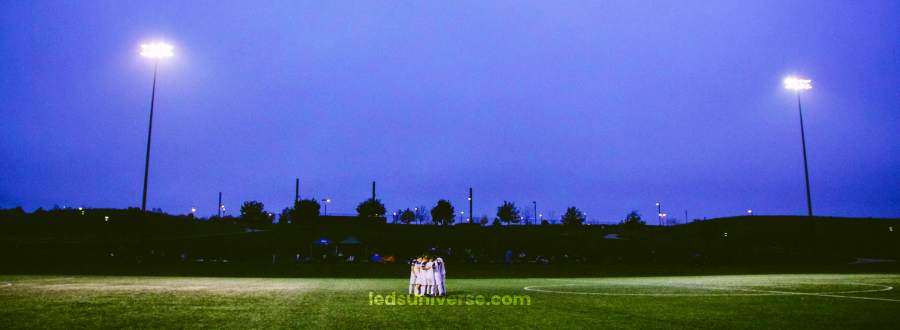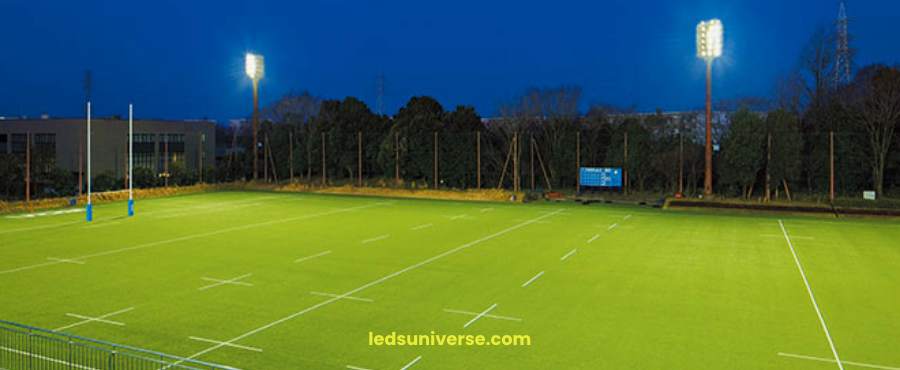Whether you’re looking at mast lighting, linear systems, or a blend of both, every design choice impacts not only game performance but also broadcast quality and safety. Dive into the world of rugby field lighting and discover how thoughtful design and meticulous maintenance can illuminate every match with clarity and precision!
Rugby field lighting must adhere to specific regulations and standards to effectively meet the diverse needs of players, spectators, and broadcast coverage. These regulations are designed to ensure that lighting conditions are optimal for safety, performance, and viewer experience. For players, proper illumination is crucial to maintain visibility and reduce the risk of injuries. Adequate lighting helps players to clearly see the ball, their teammates, and the field markings, thus supporting their performance and reducing the likelihood of accidents during play.
Reach out for free lighting consultation
Table of Contents
ToggleWhen designing lighting for rugby fields, adherence to established standards is crucial for ensuring that the lighting system meets the necessary performance and safety criteria. Standards such as the European standard EN 12193:1999 provide detailed guidelines on the required illumination levels for different types of games and competitions. This standard specifies the minimum lighting intensity and uniformity needed to ensure that players can perform safely and effectively, referees can make accurate calls, and spectators can enjoy a clear view of the game.

Compliance with these standards is not merely a matter of meeting technical specifications; it also reflects a commitment to creating a high-quality playing environment. For players, adequate illumination reduces the risk of accidents and injuries by ensuring that the entire field is evenly lit and that all key elements, such as the ball and field markings, are clearly visible. For referees and officials, proper lighting is essential for making accurate decisions and maintaining the flow of the game. Spectators, both on-site and those watching broadcasts, benefit from clear and consistent lighting that enhances the overall viewing experience.
In addition to meeting these requirements, lighting design must also support high-quality broadcast coverage. Television and media productions have specific lighting needs to ensure that the game is captured in vivid detail, with minimal interference from shadows and glare. By adhering to established standards, designers can ensure that the lighting system is suitable for live broadcasts and supports the global visibility of the sport.
One of the challenges in rugby field lighting is managing glare and shadows, which can significantly impact visibility and performance. Glare occurs when light is directed in a way that it becomes uncomfortable or obstructive to players and spectators. It can result from poorly positioned floodlights or high-intensity light sources that are not properly shielded. Shadows, on the other hand, can create uneven lighting conditions that may obscure parts of the field or affect the visibility of the ball and players.
To address these issues, it is crucial to carefully design the placement and angle of lighting fixtures. For mast lighting systems, this often involves selecting floodlights with advanced glare-reducing features and optimizing the height and positioning of the masts. By carefully angling the floodlights and using fixtures that minimize light spill and reflection, designers can reduce glare and ensure that the light is directed effectively onto the playing surface.
In linear lighting systems, the focus is on placing floodlights along the length of the field in a way that minimizes shadows and provides uniform illumination. This may involve mounting floodlights above the stands or on specially designed structures to ensure that the light distribution is even across the field. By strategically positioning the lights and adjusting their angles, designers can reduce the depth of shadows and enhance overall visibility.
The adoption of LED technology has become a popular choice due to its numerous advantages over traditional lighting options. LED lights are known for their energy efficiency, consuming significantly less power compared to halogen or metal halide lamps. This reduction in energy consumption translates to lower operational costs and a smaller environmental footprint.
In addition to being energy-efficient, LED lights have a long lifespan, which reduces the frequency of replacements and the associated maintenance costs. This longevity contributes to overall cost savings and ensures that the lighting system remains reliable and effective over time. LEDs also offer superior control over light distribution, allowing for precise adjustments to meet specific illumination needs and minimize issues such as glare and shadows.
Moreover, LED technology supports advanced control systems, such as dimming and smart lighting features, which can further enhance energy efficiency. These systems allow for adaptive lighting solutions that adjust based on factors such as ambient light levels, time of day, or specific event requirements. By incorporating these advanced features, lighting designers can optimize energy usage and maintain high-quality illumination while minimizing costs.

| Type of Rugby Field Lighting | Description | Advantages | Disadvantages |
|---|---|---|---|
| Mast Lighting Systems | Uses four tall masts at the corners of the field, each with high-intensity floodlights. | Meets basic lighting requirements; effective coverage. | High construction costs; creates multiple shadows on the field; may need additional lighting to improve illumination quality. |
| Linear Lighting Systems | Floodlights are placed along the long sides of the field, either above the stands or on specially designed structures. | Ensures even illumination; reduces shadow depth; effective for smaller fields. | High installation costs; may be less effective for large fields; can require significant infrastructure. |
| Mixed Lighting Systems | Combines tall masts with floodlights mounted along the field’s sides to achieve optimal lighting conditions. | Reduces shadows; improves overall visibility; addresses limitations of mast-only or linear systems. | Higher installation and maintenance costs; complex setup. |
Mast lighting systems are among the most commonly used for rugby fields. These systems typically involve four tall masts, each located at the corners of the pitch. Each mast is equipped with high-intensity floodlights designed to provide adequate coverage and meet the necessary lighting standards. While mast systems can effectively meet basic lighting requirements, they have some drawbacks. The need for high masts to minimize glare can lead to significant construction costs. Additionally, the four-mast configuration can create multiple shadows on the field, which can affect player visibility and performance. To counteract these issues, some systems incorporate additional lighting elements, such as floodlights mounted on building supports or other structures, to improve the overall quality of illumination.
Linear lighting systems involve placing floodlights along the long sides of the field, either mounted above the stands or on specially designed structures. This configuration ensures even illumination and reduces shadow depth, providing better visibility for both players and spectators. Linear systems can be particularly effective for smaller sports grounds where mast heights are not as significant. However, the cost of installation for linear lighting systems can be relatively high. Despite this, the benefits of improved visibility and reduced shadowing often justify the investment, especially for fields used for televised games or high-level competitions.
Mixed lighting systems combine elements of both mast and linear lighting approaches. These systems use a combination of tall masts and floodlights mounted along the sides of the field to achieve optimal lighting conditions. By integrating multiple lighting sources, mixed systems can address some of the limitations of mast-only or linear-only systems. For example, they can reduce the number of shadows and improve overall field visibility. However, this combination can also lead to increased installation and maintenance costs, making it essential to balance performance needs with budget constraints.
To ensure the longevity and optimal performance of rugby field lighting, regular inspections are crucial. These inspections should be conducted systematically to assess the condition of all lighting components, including fixtures, wiring, and control systems. During these routine checks, it is important to look for any signs of wear, damage, or deterioration. For example, inspect the fixtures for cracks, rust, or loose parts, and examine the wiring for frayed or exposed sections. Addressing any issues promptly can prevent more significant problems from developing, such as electrical failures or safety hazards.
Regular inspections also help maintain the lighting system’s efficiency and compliance with required standards. Ensuring that all components are functioning correctly and that the system is operating within specified parameters is essential for providing consistent illumination and meeting safety requirements. Scheduling these inspections at regular intervals, such as before and after the peak usage seasons, can help identify and resolve potential issues before they impact the performance of the lighting system.
Over time, lighting fixtures are exposed to various environmental factors that can cause the accumulation of dirt, dust, and other contaminants. This buildup can significantly affect the performance of the lights by reducing brightness, causing uneven illumination, or leading to operational issues. To maintain optimal light output and ensure that the field remains well-lit, regular cleaning of the fixtures is necessary. This involves removing debris from lenses and reflectors, wiping down the exterior surfaces, and ensuring that no obstructions are present.
In addition to cleaning, periodic replacement of components such as bulbs and lenses is essential. Bulbs have a finite lifespan and may dim or fail over time, while lenses can become scratched or clouded. Replacing these components according to the manufacturer’s recommendations helps maintain consistent lighting quality and extends the overall lifespan of the system. Keeping an inventory of spare parts and having a scheduled replacement plan can help ensure that the system remains operational and that any issues are addressed promptly.
Electrical issues are a common concern in maintaining rugby field lighting systems and can impact both performance and safety. Problems with wiring, connections, or control systems can lead to issues such as flickering lights, power outages, or even complete system failures. To prevent these issues, it is crucial to conduct regular electrical checks and maintenance. This includes inspecting connections for signs of corrosion, ensuring that all wiring is intact and properly insulated, and testing control systems for proper functionality.
Promptly addressing any electrical problems is essential for the safe and reliable operation of the lighting system. This may involve tightening loose connections, repairing damaged wires, or replacing faulty control components. Engaging a qualified electrician for more complex electrical issues or system upgrades can ensure that repairs are conducted safely and in compliance with electrical codes and standards.
By understanding the different types of lighting systems, considering key design factors, and implementing regular maintenance practices, facility managers can create well-lit rugby fields that meet regulatory standards and enhance the overall game experience. Whether using mast, linear, or mixed lighting systems, careful planning and ongoing upkeep are vital for achieving the best possible results.